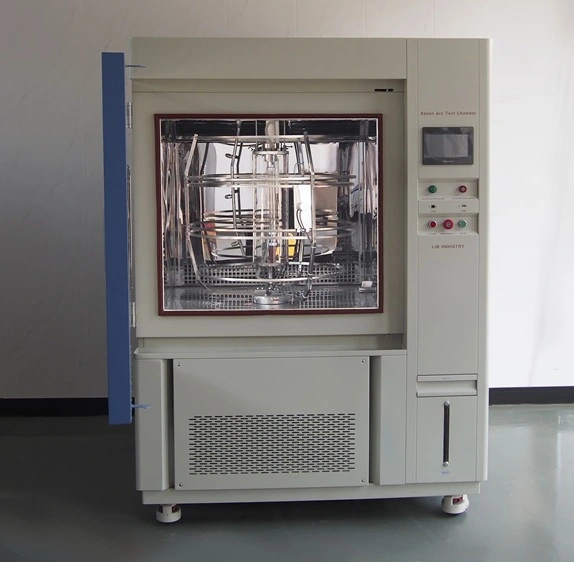How Xenon Chambers Perform Accurate UV Aging Tests?
How Xenon Chambers Perform Accurate UV Aging Tests?
LIB Xenon chambers deliver precise UV aging assessments through advanced spectral simulation technology that replicates natural sunlight conditions with remarkable accuracy. These sophisticated testing instruments utilize xenon arc lamps to generate full-spectrum radiation spanning from ultraviolet through visible to infrared wavelengths, creating authentic weathering environments within controlled laboratory settings. By maintaining consistent irradiance levels between 35-150 W/㎡ and precise temperature control from ambient conditions up to 100°C, these chambers enable manufacturers to evaluate material degradation patterns, color fastness properties, and structural integrity changes that would naturally occur over extended outdoor exposure periods.

What Is the Principle Behind Xenon Arc Testing?
Understanding Xenon Arc Light Sources
Xenon arc technology forms the cornerstone of accurate UV aging simulation by generating light spectra that closely match natural sunlight characteristics. The xenon gas discharge process creates continuous wavelength emission across ultraviolet, visible, and infrared regions, producing spectral distributions that mirror solar radiation patterns encountered in real-world applications.
Photochemical Degradation Mechanisms
Material degradation occurs through complex photochemical reactions initiated by specific wavelength absorption. Xenon chambers replicate these mechanisms by delivering controlled energy doses at critical wavelengths, particularly within the 300-400nm bandwidth range where most polymer and coating degradation processes initiate.
Accelerated Aging Principles
The acceleration factor in xenon testing stems from concentrated irradiance exposure combined with elevated temperature and humidity conditions. This controlled intensification enables researchers to observe material changes that would typically require months or years of natural weathering within compressed timeframes.
Simulating Full-Spectrum Sunlight with Xenon Lamps
Spectral Distribution Characteristics
Xenon arc lamps produce continuous emission spectra spanning wavelengths from 200nm to 3000nm, encompassing the complete solar spectrum range. This comprehensive coverage ensures that all photodegradation pathways active in natural weathering conditions remain operational during laboratory testing procedures.
Optical Filter Systems
Advanced filter combinations modify xenon lamp output to match specific geographic locations or seasonal variations. These optical elements eliminate unwanted wavelengths while enhancing target spectral regions, creating customized exposure conditions that reflect particular environmental scenarios.
Irradiance Calibration Methods
Precise irradiance measurement and calibration ensure consistent energy delivery throughout testing cycles. Calibrated sensors monitor output intensity at reference wavelengths (340nm or 420nm), maintaining stable exposure conditions that enable reproducible results across multiple test campaigns.
Parameter | Specification | Purpose |
Irradiance Range | 35-150 W/㎡ | Controls exposure intensity |
Bandwidth Measurement | 300-400nm | Monitors critical UV range |
Calibration Wavelength | 340nm or 420nm | Reference point stability |
Controlling Temperature, Humidity, and Irradiance
Temperature Management Systems
Xenon chamber temperature regulation between ambient conditions and 100°C (±2°C tolerance) enables accurate simulation of thermal stress conditions that materials encounter during outdoor service. Black panel temperature monitoring (BPT 35-85°C ±2°C) provides direct surface temperature measurement, reflecting actual material heating under solar radiation.
Humidity Control Mechanisms
Relative humidity regulation within the 50-98% RH range (±5% RH deviation) replicates moisture exposure conditions that accelerate hydrolytic degradation processes. Precise humidity control systems maintain stable water vapor concentrations throughout extended testing periods.
Irradiance Stability Features
Sophisticated feedback control systems continuously monitor and adjust xenon lamp output to maintain consistent irradiance levels. These automated systems compensate for lamp aging effects and ensure uniform energy delivery across specimen surfaces throughout the testing duration.
Environmental Parameter | Range | Tolerance | Function |
Chamber Temperature | Ambient - 100°C | ±2°C | Thermal stress simulation |
Black Panel Temperature | 35 - 85°C | ±2°C | Surface heating measurement |
Relative Humidity | 50-98% | ±5% RH | Moisture exposure control |
Specimen Placement and Uniform Light Exposure
Sample Mounting Configurations
Proper specimen positioning within the xenon chamber ensures uniform irradiance distribution across all test surfaces. Rotating drum systems or stationary rack configurations provide consistent exposure angles while accommodating various sample geometries and dimensions.
Distance Optimization Strategies
Strategic specimen placement at optimal distances from the xenon light source maximizes irradiance uniformity while preventing excessive thermal stress. Geometric considerations account for inverse square law effects and beam divergence characteristics inherent in xenon arc systems.
Exposure Area Calculations
Chamber design specifications define maximum effective exposure areas where irradiance uniformity meets established testing standards. Understanding these spatial limitations ensures reliable results and prevents edge effects that could compromise data quality.
Monitoring Test Duration and Degradation Indicators
Exposure Time Programming
Sophisticated control systems enable precise programming of exposure cycles, including continuous irradiation periods, dark cycles, and water spray sequences. These programmable features replicate diurnal variations and precipitation events that materials experience during natural weathering.
Visual Assessment Protocols
Regular visual examination of specimen surfaces reveals color changes, surface chalking, cracking, and other degradation indicators that develop during UV exposure. Standardized evaluation methods quantify these changes using established rating scales and measurement techniques.
Instrumental Analysis Methods
Advanced analytical techniques complement visual assessments by providing quantitative measurements of material property changes. Spectrophotometric color analysis, gloss measurements, and mechanical property evaluations generate objective data supporting weathering performance conclusions.
Monitoring Aspect | Method | Frequency | Purpose |
Color Change | Spectrophotometry | Daily/Weekly | Quantify chromatic shifts |
Surface Gloss | Gloss Meter | Weekly | Track surface degradation |
Mechanical Properties | Tensile Testing | Periodic | Assess structural integrity |
Standards Governing UV Aging Using Xenon Chambers
International Testing Standards
Multiple international standards govern xenon arc weathering procedures, including ASTM G155, ISO 4892-2, and JIS K 7350 specifications. These comprehensive documents establish testing parameters, specimen preparation methods, and result interpretation guidelines that ensure global consistency in weathering assessments.
Industry-Specific Requirements
Automotive, aerospace, textile, and coating industries maintain specialized testing protocols adapted to their unique material requirements and service conditions. These sector-specific standards address particular degradation modes and performance criteria relevant to each application area.
Calibration and Validation Procedures
Regular calibration using reference materials and standard procedures maintains testing accuracy and enables interlaboratory comparisons. Validation protocols verify equipment performance and ensure compliance with applicable testing standards throughout the operational lifecycle.
Accurate & Reproducible UV Simulation Technology - LIB Industry
Advanced Chamber Design Features
LIB Industry xenon chambers incorporate precision-engineered components that deliver exceptional performance reliability and measurement accuracy. The robust construction utilizing high-quality materials ensures consistent operation under demanding testing conditions while maintaining calibration stability over extended service periods.
Customization Capabilities
Comprehensive customization options accommodate diverse testing requirements across multiple industries. Dimensional modifications, specialized control parameters, and enhanced feature packages provide flexibility for addressing unique application needs while maintaining core performance specifications.
Technical Support and Training
Complete turnkey solutions encompass research, design, production, commissioning, delivery, installation, and comprehensive training programs. This integrated approach ensures optimal equipment utilization and maximizes testing program effectiveness for customers worldwide.
Conclusion
Xenon chambers represent the gold standard for accurate UV aging assessments through their sophisticated integration of full-spectrum light sources, precise environmental controls, and standardized testing protocols. These advanced instruments enable manufacturers to evaluate material durability, predict service life, and optimize product formulations with confidence. The combination of realistic solar simulation, controlled exposure conditions, and comprehensive monitoring capabilities makes xenon testing an indispensable tool for quality assurance and product development across diverse industries.
FAQ
How long do typical xenon chamber UV aging tests require?
Test durations vary significantly based on material type and performance requirements, ranging from hundreds to several thousand hours of exposure, depending on the specific degradation endpoints being evaluated.
What maintenance requirements apply to xenon arc lamps?
Xenon lamps typically require replacement after 1500-3000 hours of operation, with regular cleaning and calibration checks ensuring consistent spectral output and irradiance levels throughout their service life.
Can xenon chambers simulate specific geographic weathering conditions?
Advanced filter systems enable customization of spectral output to match particular geographic locations, seasonal variations, and altitude-specific solar conditions, providing targeted environmental simulation capabilities.
Ready to enhance your material testing capabilities with precision xenon chamber technology? Contact LIB Industry today at ellen@lib-industry.com to discover how our customizable weathering solutions can accelerate your product development and quality assurance programs. Our expert team provides comprehensive support from initial consultation through installation and training, ensuring optimal testing results for your specific applications.
References
1. Smith, J.R., et al. "Correlation Studies Between Natural and Artificial Weathering Using Xenon Arc Technology." Journal of Materials Testing and Evaluation, Vol. 45, No. 3, 2023.
2. Thompson, K.L. and Rodriguez, M.A. "Advances in Spectral Matching for Xenon Arc Weathering Systems." International Conference on Polymer Degradation and Stabilization Proceedings, 2024.
3. Chen, W.H., et al. "Standardization of Xenon Arc Testing Methods for Automotive Coating Applications." Surface Technology and Coatings Research, Vol. 28, No. 7, 2023.
4. Anderson, P.D. and Kumar, S. "Temperature and Humidity Control Systems in Modern Xenon Weathering Chambers: Performance Evaluation and Optimization." Testing Equipment Quarterly, Issue 2, 2024.



